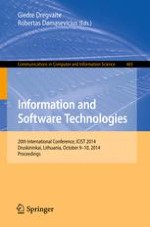2014 | Buch
Information and Software Technologies
20th International Conference, ICIST 2014, Druskininkai, Lithuania, October 9-10, 2014. Proceedings
herausgegeben von: Giedre Dregvaite, Robertas Damasevicius
Verlag: Springer International Publishing
Buchreihe : Communications in Computer and Information Science
